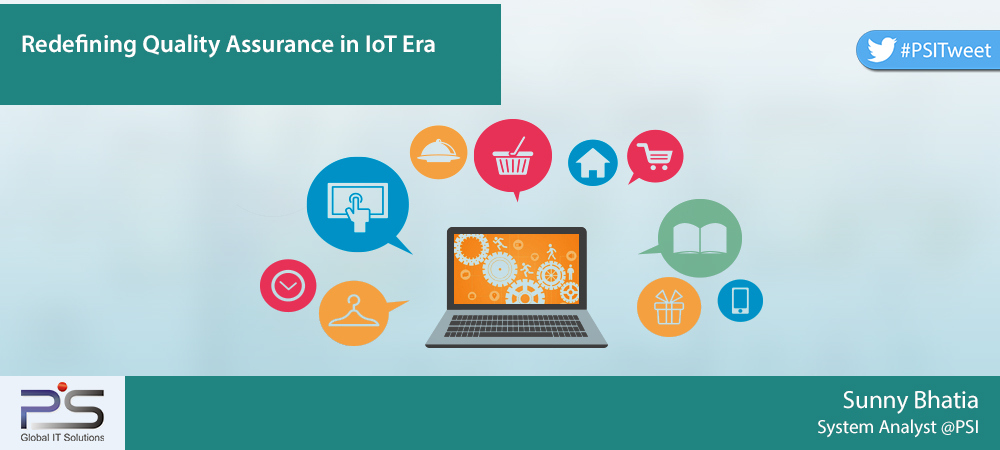
Internet of Things (IoT) is leading to rising connectivity between things and ultimately people, which is changing the dimensions of universal computing. With the proliferation of devices and cross platform compatibility issues, ensuring quality is a major concern. In this context I believe everything comes down to the qualification phase, which determines the entire QA process.
Nevertheless, Quality Assurance is no longer about testing on devices and operating systems; it is a holistic approach to manage the technical complexities across a connected ecosystem. In the IoT age Quality Assurance needs to embrace the changing technology requirements and redefine itself.
Challenging Factors in implementing IoT
Digitization and rise of applications for better connectivity poses major challenges in the sphere of testing & QA. These applications need to get tested before it goes in the user’s device / domain. We need to test the hardware & software components along with the performance of the application wrt enormous real time intelligence data. Some factors which might need consideration:
- Convergence of hardware and software; we need to test the components in the dynamic operating situation.
- Requirement of smooth working; Connectivity across the devices is the objective along with its quality validation.
- Enormous interactions of devices/sensors; the real time interaction among devices is a challenge for any Quality Analyst and requires in depth knowledge.
- Managing hardware/software updates; due to constant technology update devices get updated every day. During the qualification, entertaining the new framework or updates hamper the overall process of release.
- Compatibility with legacy systems; improvements and new release are the need of the technology but support for legacy systems is also required.
- Migration of devices and systems on newer platforms; the changes require movement of systems to advance levels with planning and intensive testing along with right tools for accurate functioning.
Types of testing in IoT environment
Quality assurance strategy is required to understand the IoT environment functions. This involves different testing styles, setups, tools and stimulators etc
- Device Migration testing; conducted to make sure that existing features from older systems are working as expected on newer migrated systems.
- Backward compatibility testing; essential in order to support the newer devices on older platforms as well.
- Handling Localization issues; devices/systems should understand and speak the communication languages across the world.
- Reliability testing; devices perform the same behaviour every time. Aspects to be considered before the system/devices are deployed.
- Encrypted data transferability; security of data exchanged between the devices will always remain a hot bubble issue in order to protect it from malicious attacks. Strong encryption mechanisms will hold the base for this.
- Measuring Performance while in operation; actual performance of devices comes only when they are put to use in real world. Although complete performance testing can never be performed exhaustively but it can be achieved up to some extent through simulation on virtual environment.
Actions to Consider
Many Organizations need to keep the following points as they evaluate and start the IoT journey.
- Sync with standards; the performance attributes w.r.t other devices and sensors and the industry standards
- Interoperability; devices are required to support functionality with other devices and implementations
- Security; a large number of unsecured devices and sensors pose security risks. It is crucial to resolve data privacy and security issues in IoT environment
- Network & device capability tests; network capacity and communication along with devices in different networks
- Environmental credibility; Green credentials are on priority for activists and stakeholders and will continue, yet balance needs to be maintained between the surroundings and the environment.
Potential Futuristic Markets
Healthcare Vertical
Interoperability amongst disparate systems should be established even if they are located geographically at a distance. Creating such an environment with connecting assets will enable the new value propositions. Some of them may be – Connecting Laboratory information systems across communities, hospitals, pharmacies labs for knowledge sharing on clinical terminology, familiarity on advance coming healthcare platforms, exchanging the drugs related information in real time surgeries etc. Even such systems get developed but in order to become operational they have to pass through QA testing phase. QA phase will not only help in making sure that system works as expected but also ensures their seamless communication.
Automotive Sector
Today we manually drive down to office, but it is not too far that the scenario may change where smart, energy-efficient autonomous vehicles may take us where we need to go. But the question arises how the traffic will be regulated? How the technology functional inside the cars will communicate for air traffic control? How security and efficiency of vehicles, safety of passengers will be maintained? Over and above such systems will be in place but they will need thorough testing so as to make sure that whatever data is flowing across the systems is correct, reliable and safe to use.
It is important to ensure that the mode of technological communication is not cumbersome and systems can talk to each other. This makes QA and testing indispensable.Internet of Things(IoT) is leading to rising connectivity between things and ultimately people, which is changing the dimensions of universal computing. With the proliferation of devices and cross platform compatibility issues, ensuring quality is a major concern. In this context I believe everything comes down to the qualification phase, which determines the entire QA process.
Nevertheless, Quality Assurance is no longer about testing on devices and operating systems; it is a holistic approach to manage the technical complexities across a connected ecosystem. In the IoT ageQuality Assurance needs to embrace the changing technology requirements and redefine itself.
Challenging Factors in implementing IoT
Digitization and rise of applications for better connectivity poses major challenges in the sphere of testing & QA. These applications need to get tested before it goes in the user’s device / domain. We need to test the hardware & software components along with the performance of the application wrt enormous real time intelligence data. Some factors which might needs consideration:
- Convergence of hardware and software; we need to test the components in the dynamic operating situation.
- Requirement of smooth working; Connectivity across the devices is the objective along with its quality validation.
- Enormous interactions of devices/sensors; the real time interaction among devices is a challenge for any Quality Analyst and requires in depth knowledge.
- Managing hardware/software updates; due to constant technology update devices get updated every day. During the qualification, entertaining the new framework or updates hamper the overall process of release.
- Compatibility with legacy systems; improvements and new release are the need of the technology but support for legacy systems is also required.
- Migration of devices and systems on newer platforms; the changes require movement of systems to advance levels with planning and intensive testing along with right tools for accurate functioning.
Types of testing in IoT environment
Quality assurance strategy is required to understand the IoT environment functions. This involves different testing styles, setups, tools and stimulators etc
- Device Migration testing; conducted to make sure that existing features from older systems are working as expected on newer migrated systems.
- Backward compatibility testing; essential in order to support the newer devices on older platforms as well.
- Handling Localization issues; devices/systems should understand and speak the communication languages across the world.
- Reliability testing; devices perform the same behaviour every time. Aspects to be considered before the system/devices are deployed.
- Encrypted data transferability; security of data exchanged between the devices will always remain a hot bubble issue in order to protect it from malicious attacks. Strong encryption mechanisms will hold the base for this.
- Measuring Performance while in operation; actual performance of devices comes only when they are put to use in real world. Although complete performance testing can never be performed exhaustively but it can be achieved up to some extent through simulation on virtual environment.
Actions to Consider
Many Organizations need to keep the following points as they evaluate and start the IoT journey.
- Sync with standards; the performance attributes wrt other devices and sensors and the industry standards
- Interoperability; devices are required to support functionality with other devices and implementations
- Security; the large number of unsecured devices and sensors pose security risks. It is crucial to resolve data privacy and security issues in IoT environment
- Network & device capability tests; network capacity and communication along with devices in different networks
- Environmental credibility;Green credentials are on priority for activists and stakeholders and will continue, yet balance needs to be maintained between the surroundings and the environment.
Potential Futuristic Markets
Healthcare Vertical
Interoperability amongst disparate systems should be established even if they are located geographically at a distance. Creating such an environment with connecting assets will enable the new value propositions. Some of them may be – Connecting Laboratory information systems across communities, hospitals, pharmacies labs for knowledge sharing on clinical terminology, familiarity on advance coming healthcare platforms, exchanging the drugs related information in real time surgeriesetc. Even such systems get developed but in order to become operational they have to pass through QA testing phase. QA phase will not only help in making sure that system works as expected but also ensures their seamless communication.
Automotive Sector
Today we manually drive down to office, but it is not too far that the scenario may change where smart, energy-efficient autonomous vehicles may take us where we need to go. But the question arises how the traffic will be regulated? How the technology functional inside the cars will communicate for air traffic control? How security and efficiency of vehicles, safety of passengers will be maintained? Over and above such systems will be in place but they will need thorough testing so as to make sure that whatever data is flowing across the systems is correct, reliable and safe to use.
It is important to ensure that the mode of technological communication is not cumbersome and systems can talk to each other. This makes QA and testing indispensable.[:]








